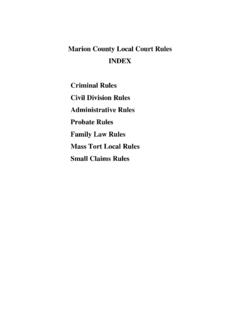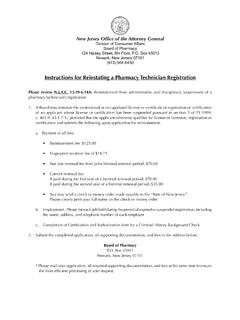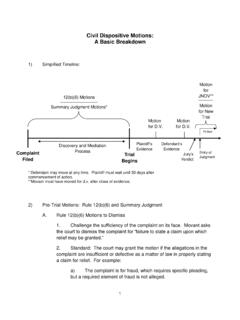Transcription of Racial 3 Discrimination in the Criminal Justice System
1 653 Racial Discrimination in the Criminal Justice System Ethical BackgroundIt is generally agreed that Discrimination based on Racial or ethnic origin is morally wrong and a violation of the principle of equality. The equality principle requires that those who are equal be treated equally based on similarities, and that race not be a relevant consideration in that assess-ment (May and Sharratt 1994: 317). In other words, it is only possible to justify treating people differently if there exists some factual difference between them that justifies such difference in treatment (Rachels 1999: 94). Equality is a nonspecific term that means nothing until applied to a particular context. Thus, in a political context, equality means equal access to public office and equal treatment under the law, and equal treatment extends to equality in terms of job hiring, promotion, and refers to groups of persons who are relatively alike in their biological inheritance and are distinct from other groups (American Anthropological Association 1997: 2).
2 Ethnicity is a cultural phenomenon referring to a person s identification with a particular cultural group (Hinman 1998: 403). However, race is socially constructed, and the notion that persons belong to a particular race was developed in the last century based on the belief that there was a biological basis for categorizing groups of people. Biologically, however, the term race has no meaning, yet society continues to give the notion meaning by using it as a social category. The notion of race gradually took hold in society when the institution of slavery reinforced the idea that one race could be inferior to another (Banks and Eberhardt 1998: 58). In the United States, the law has had the effect of distributing benefits and burdens based on race, and the assignment of a person to a Racial category has often, in the past, determined his or her rights and obligations ( , in the Jim Crow laws passed at the end of the Civil War).Racism in its most general sense can be defined as social practices which (explicitly or implicitly) attribute merits or allocate values to members of racially categorized groups solely because of their race (Zatz and Mann 1998: 3).
3 There are at least three aspects to racism: personal prejudice; ideological racism, where culture and biology are used to rationalize and justify the superior position of a dominant culture; and institutional racism, where the policies and practices of institutions operate to produce systematic and continuing differences between Racial groups (p. 4).Part I The Interaction Between Ethics and the Criminal Justice System66 One aspect of institutionalized racism has been termed petit apartheid. This concept includes daily informal or hidden interactions between police and minorities, such as stop-and-question and stop-and-search law enforcement practices, which may or may not result in an arrest and consequent entry into the Criminal Justice System (Zatz and Mann 1998: 4). The notion of petit apartheid has recently been explored both theoretically and in terms of those activities that might fall within its definitional scope (Milovanovic and Russell 2001). The focus of petit apartheid appears to be attitudinal factors that influence policing and other decisions within the System , that is, culturally biased beliefs and actions extending, in the view of Daniel Georges-Abeyie (2001: x), to insults, rough treatment, and lack of civility faced by black suspects, the quality and objectivity of judicial instructions to a jury when an African American is on trial, and other discretionary acts within the apartheid contrasts with grand apartheid.
4 The latter encompasses overt racism. Studies on racism within the Criminal Justice System have been critiqued for giving undue emphasis to overt racism and ignoring petit apartheid (Georges-Abeyie 2001: x). This chapter aims to explore overt racism within the Criminal Justice System . Issues such as Racial profiling and Racial slurs, which appear to constitute an aspect of petit apartheid as well as being discriminatory practices, have already been discussed in Chapter 2. Historical ContextAfrican Americans have suffered Discrimination on grounds of race, initially through the System of slavery, and then through a pattern of exclusion and segregation, both informal and formal, in the shape of legislation and court decisions that have historically endorsed overt Racial dis-crimination. From the time of the inception of slavery in the early 17th century until 1865, slaves were considered the property of their masters based on a view that they were naturally unequal and inferior people.
5 They were subjected to slave codes, which prohibited the possession of any rights or freedoms enjoyed by whites; experienced brutal and inhumane treatment of an extrale-gal nature; and were exploited for their labor. Following the Civil War, amendments to the Bill of Rights prohibited slavery and granted all persons, regardless of race, a right to equal protection. However, despite these legal statements of freedom, patterns of Discrimination persisted after the war because many states passed Jim Crow laws, which had the effect of maintaining forms of dis-crimination in legal, social, and economic forums. For example, African Americans were denied the right to vote or to enter into contracts, and the doctrine of separate but equal was applied to keep the races courts continued to enforce Jim Crow laws until the mid-1900s, and African Americans were also subjected to extralegal treatment in the form of physical assaults and practices such as lynching, where police were often present.
6 About 3,000 African Americans were lynched between the mid-1800s and the early 1900s (B. Smith 2000: 75), and those performing the lynchings were seldom prosecuted. During the 20th century, legal rights were accorded to African Americans and have been protected by the courts. In the landmark case of Brown v. Board of Education in 1954, the Supreme Court struck down the separate but equal doctrine, and the civil rights acts passed in the mid-20th century attempted to restate and reinforce a policy against , the black community in the United States is diverse, comprising, for example, Jamaicans, Nigerians, Ethiopians, Somalis, and other African and West Indies nationalities, each with its own culture distinguishable from that of African Americans. Nevertheless, despite this heterogeneity, racist attitudes continue to be manifested based on skin history of Latinos in the United States has been one of contention with the Anglo American culture. Spanish colonies were established in the United States in the late 16th century, predating the Anglo American presence; however, in 1847, Mexico lost approximately half of its territory to the United States.
7 In recent times, it has been common to associate Latinos with the Chapter 3 Racial Discrimination in the Criminal Justice System67issue of immigration, and Mexicans in particular are constructed as an illegal immigrant group (De Uriarte in Alvarez 2000: 88). Racist stereotyping of Latinos depicts them as sneaky, lazy, and thieving (Levin in Alvarez 2000: 88), and law enforcement practices and the Criminal Justice System have been shown to collaborate in Discrimination against Latinos in the form of police harassment of Mexican Americans (Turner in Alvarez 2000: 88).It is important to appreciate the heterogeneity of the Latino population in the United States, because issues affecting Mexican Americans may differ from those impacting Puerto Ricans, Cubans, or immigrants from Central America. For example, Puerto Ricans are the most economically disadvantaged group (Myers et al. in Alvarez 2000: 89), whereas Cuban immigrants to the United States have tended to come from the middle class, be well educated, and possess significant economic resources.
8 Nevertheless, like African Americans and other black groups, the heterogeneous Latino population tends to be viewed as Indians and Alaska Natives are the only indigenous groups in the United States. The history of contact between American Indians and Anglo Americans is replete with acts of violence against American Indians and with the dispossession of their lands. Alaska Natives, as a colonized and marginalized people, have experienced and continue to experience severe trauma generated by social change, with high rates of suicide, alcohol abuse, and a disproportionate representation in the Criminal Justice System (see, , Banks 2002; Brod 1975; Fienup-Riordan 1994; Kraus and Buffler 1979; Travis in Phillips and Inui 1986; Schafer, Curtis, and Atwell 1997). Similarly, American Indians continue to be disproportionately represented in arrest and incarceration data in those states where they are primarily located (see, , Greenfeld and Smith 1999; Grobsmith 1994; Perry 2004; Ross 2000).
9 Both groups suffer economic, educational, and social stereotyping, which is revealed in their treatment by the Criminal Justice terms of Criminal victimization, blacks disproportionately commit and are victimized by violent crime. They are almost 7 times as likely as whites to be murdered and about twice as likely to be robbed, raped, or sexually assaulted (Banks, Eberhardt, and Ross 2006: 1177). Although they make up less than 13% of the population, in 2004 blacks were arrested for of murders, of robberies, of rapes, and of assaults (p. 1178). Blacks represented 45% of the incarcerated population in state and federal prisons in 2002 (Harrison and Beck 2003) and more than 40% in 2004 (Harrison and Beck 2005). In 2001, American Indians represented of all offenders entering federal prison and about 16% of all violent offenders in federal prisons (Perry 2004: 21), and they made up of the total population in the 2000 Census (p. 1). Is There Racial Discrimination in the Criminal Justice System ?
10 One report suggests that Racial Discrimination does occur at some points in the Criminal Justice System . Following the Rodney King incident, the report of the Independent Commission on the Los Angeles Police Department (also called the Christopher Commission) (1991) found that there was excessive use of force by LAPD officers and that this was compounded by racism and bias. One quarter of the 960 LAPD officers surveyed by the commission agreed that officers held a Racial bias toward minorities, and more than one quarter agreed that this Racial bias could lead to the use of excessive force. The commission also reviewed radio transmissions within the LAPD, which revealed disturbing and recurrent Racial remarks, often made in the context of discussing vehicle pursuits or beating suspects. Testimony from witnesses depicted the LAPD as an organi-zation whose practices and procedures tolerated discriminatory treatment, and witnesses repeat-edly testified about LAPD officers who verbally harassed minorities, detained African American and Latino men who fit generalized descriptions of subjects, and employed invasive and humili-ating tactics against minorities in minority neighborhoods.















